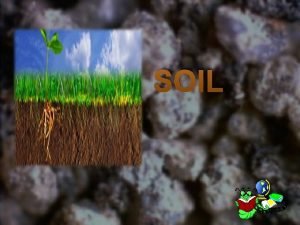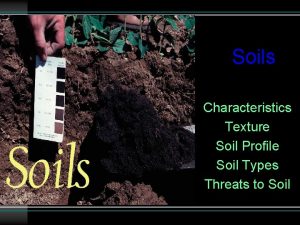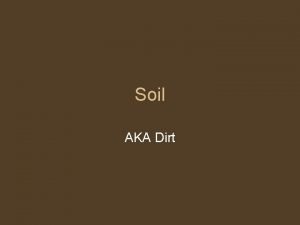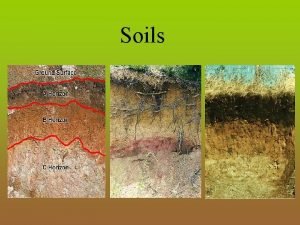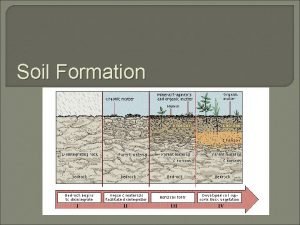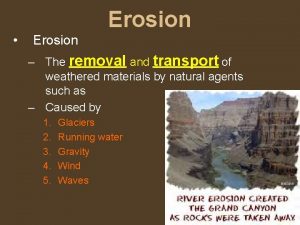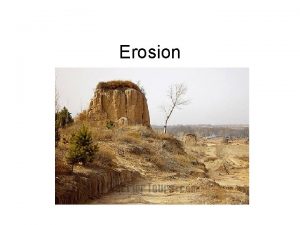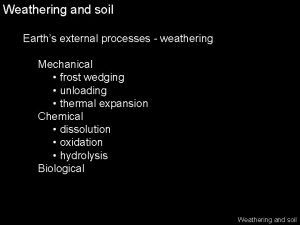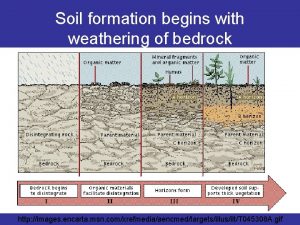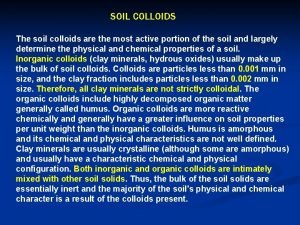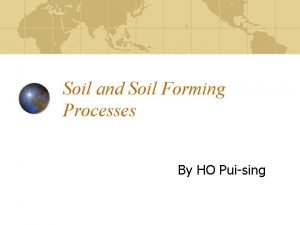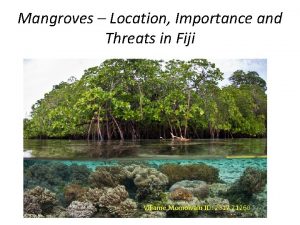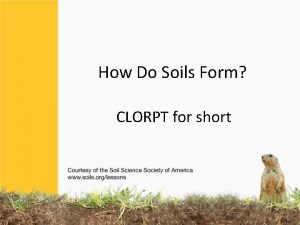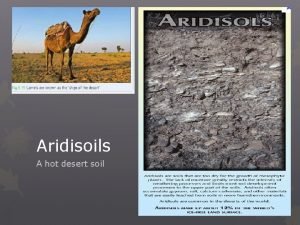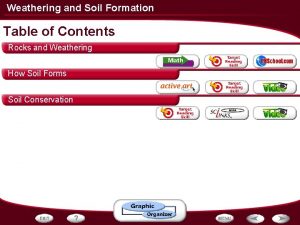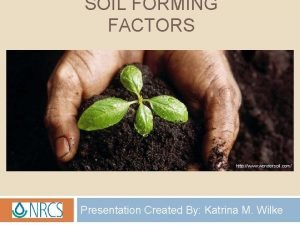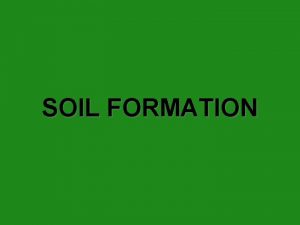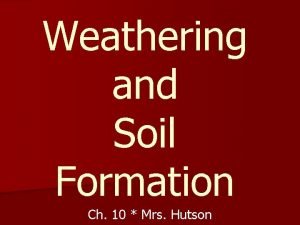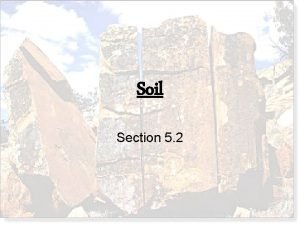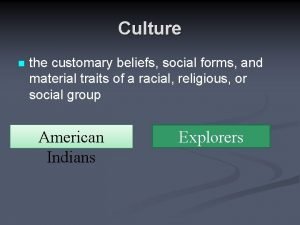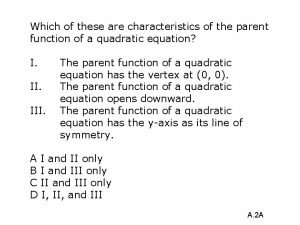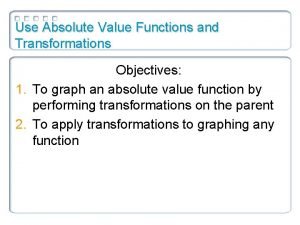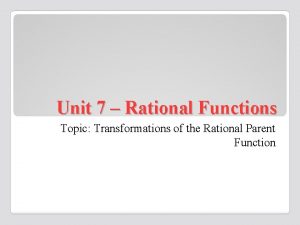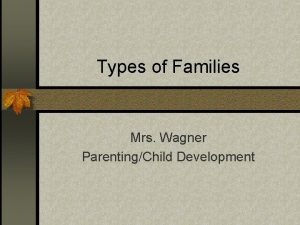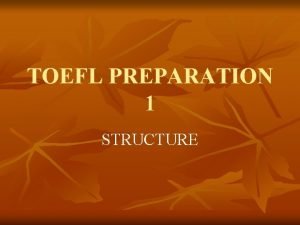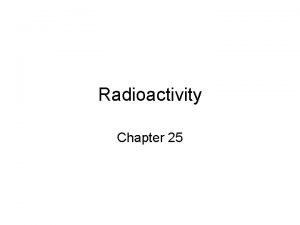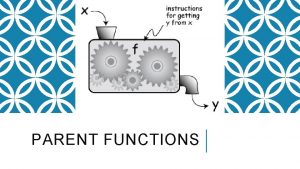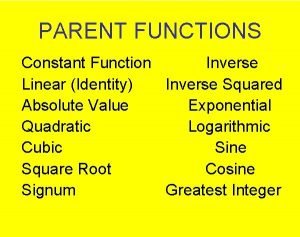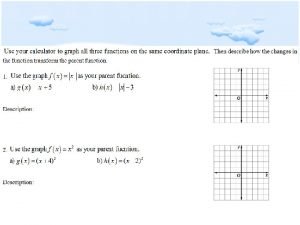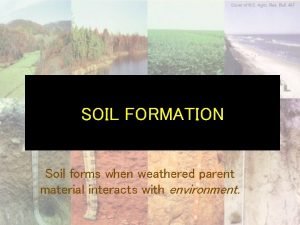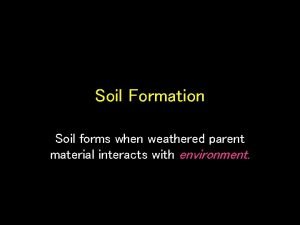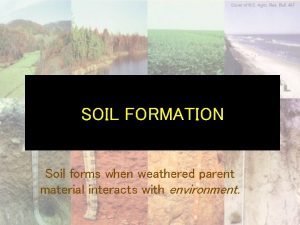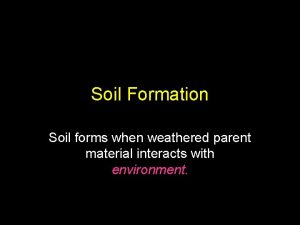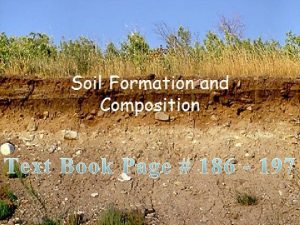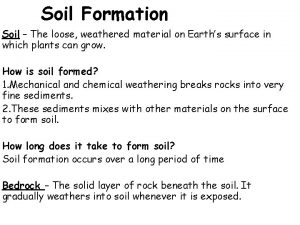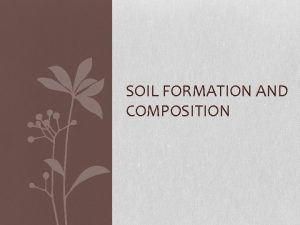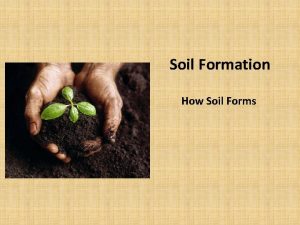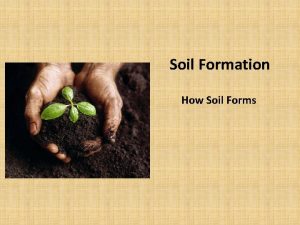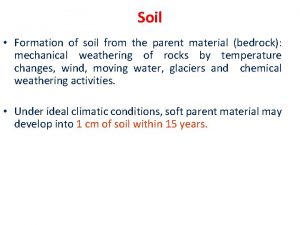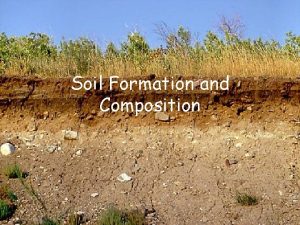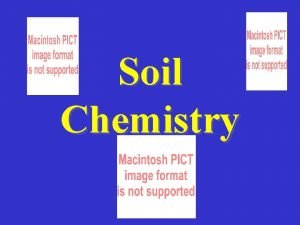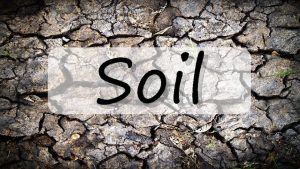SOIL FORMATION Soil forms when weathered parent material


































































- Slides: 66

SOIL FORMATION Soil forms when weathered parent material interacts with environment.

weathering • Wearing parent material down – PHYSICALLY – CHEMICALLY

Physical (Mechanical): disintegration of parent material into smaller pieces increases surface area: surface area increases by about the same factor as particle size decreases.

• Chemical (Biogeochemical) acts on surfaces: primary minerals are broken down and secondary minerals are formed.

• Soil forms when weathered parent material interacts with the environment. What would constitute the ENVIRONMENT of a soil?

• Soil carbonic acid (formed from LIFE in soil) extracts minerals from soil (which came from parent material)

How fast does soil form? Not very. Slow-------------------Fast ~ 1 cm/1000 yr ~ 30 cm/50 yr

Hans Jenny • 1941: soil is open system, properties are functionally related; system changes when property(ies) change(s). • Jenny’s CLORPT equation s = ƒ (cl, o, r, p, t) He expanded on the ideas of Dokuchaev

1. CLIMATE 2. ORGANISMS 3. RELIEF 4. PARENT MATERIAL 5. TIME

1. CLIMATE …determines speed, character of soil development: determines the type and rate of weathering determines living organisms and plants found in an area

components of climate : 1. Temperature -for every 10°C , biochemical rxn rates 2 X 2. Effective precipitation (water that moves through entire soil column, including regolith) -depth of water = depth of weathering -water moves soluble & suspended materials

• (Fig. 2. 15) High temperatu

Temperature and humidity increase the depth of weathering. High latitude Dry, SW US Humid, SE US Humid, tropics

Effective precipitation -a) seasonal distribution -b) temperature, evaporation -c) topography -d)permeability

a) Seasonal distribution of precipitation: Location B 600 mm/yr Location A 600 mm/yr 50 mm Every month 100 mm 6 rainy months only


b) Temperature and evaporation: Location A hot High Location B cool evapotranspiration 600 mm Lower effective ppt Low evapotranspiration 600 mm Higher effective ppt

Topography: level slope concave or bottom of slope (receiving)

Permeability:

2. Organisms plant and animal (Living plants and animals on and in soil) -sources of organic matter -nutrient recycling -vegetation prevents erosion -type of vegetation influences soil type -base pumping -

Type of vegetation influences soil type

Base pumping Deciduous trees are more effective base pumpers than conifers. -deciduous litter is easy to break down -cations (bases) are released so surface soils are not acidic -needles are hard to break down -basic cations leach away: soil is acidic

• Macroanimals (insects, mammals, gastropods, earthworms) – mix, bind soil; create channels for air, water

crotovinas

• night crawlers and water

• Macroanimals (insects, mammals, gastropods, earthworms) – mix, bind soil; create channels for air, water • Microanimals (nematodes, protozoa)

• Macroanimals (insects, mammals, gastropods, earthworms) – mix, bind soil; create channels for air, water • Microanimals (nematodes, protozoa) • Macroplants (the green plants) – provide organic matter, roots create channels, adsorb nutrients, release CO 2, stabilize, protect from erosion

• Macroanimals (insects, mammals, gastropods, earthworms) – mix, bind soil; create channels for air, water • Microanimals (nematodes, protozoa) • Macroplants (the green plants) – provide organic matter, roots create channels, adsorb nutrients, release CO 2, stabilize, protect from erosion • Micro “plants” (fungi, bacteria, actinomycetes, algae) – decomposers

3. Relief/Topography • important for rate of runoff, erosion, drainage


Flat valley floors and flat ridge tops: soil accumulates; (deepening>removal) Slopes: (removal> deepening)

4. Parent Material Determines: • texture, • types of weathering, • mineral make-up


Some Physical Weathering Processes: 1. Freeze/thaw

Freeze / Thaw





• Physical: 1. Freeze/thaw 2. Exfoliation

2. Exfoliation (unloading)




• Physical: 1. Freeze/thaw 2. Exfoliation 3. Abrasion

3. Abrasion (wind, water, ice) wind


water

ice

• Physical: 1. Freeze/thaw 2. Exfoliation 3. Abrasion 4. Salt wedging

4. Salt Wedging

• Physical: 1. Freeze/thaw 2. Exfoliation 3. Abrasion 4. Salt wedging 5. Root wedging

5. Root Wedging

• Chemical (biogeochemical): 1. Hydrolysis: minerals react with H 2 O H+ replace soluble parts; OH- combine with mineral cations 2. Hydration: mineral combines with H 2 O 3. Oxidation: mineral combines with O 2 (lose electron) Reduction: loss of O 2 (gain electron) 4. Carbonation: oxides combine with acids to make carbonates 5. Complexation: organic acids form organic complexes with metal cations


5. Time • Amount of time soil has been exposed to weathering and soil forming processes influences soil properties. – Jenny’s staircase – Ohio/Ky.



4 soil forming processes: (pedogenic) Transformation


4 soil forming processes: Transformation Translocation


4 soil forming processes: Transformation Translocation Addition


4 soil forming processes: Transformation Translocation Addition Loss

 Soil is a mixture of weathered rock and
Soil is a mixture of weathered rock and What is subsoil
What is subsoil Characteristics of soil
Characteristics of soil Soil located above its parent material
Soil located above its parent material Soil horizon parent material
Soil horizon parent material Soil horizon parent material
Soil horizon parent material Materials transported due to erosion
Materials transported due to erosion Rhyming scheme of o captain my captain
Rhyming scheme of o captain my captain The process by which natural forces move weathered
The process by which natural forces move weathered Formation initiale vs formation continue
Formation initiale vs formation continue Mechanical and chemical weathering venn diagram
Mechanical and chemical weathering venn diagram Soil formation begins with weathering of
Soil formation begins with weathering of Soil colloids size
Soil colloids size Eluviation and illuviation
Eluviation and illuviation Soil science simplified
Soil science simplified Soil formation
Soil formation O a b c r
O a b c r Clorpt model
Clorpt model Hot desert soil
Hot desert soil 5 factors of soil formation
5 factors of soil formation Formation of soil
Formation of soil Volume composition of soil
Volume composition of soil How soil is formed
How soil is formed Importance of soil formation
Importance of soil formation Venn diagram of mechanical and chemical weathering
Venn diagram of mechanical and chemical weathering Living soil vs dead soil
Living soil vs dead soil What are the four spheres of the earth
What are the four spheres of the earth Pedalfer soils would most likely be found
Pedalfer soils would most likely be found Gdt symbol
Gdt symbol Time variance
Time variance Examples of popular culture
Examples of popular culture The knowledge language values customs and material objects
The knowledge language values customs and material objects Example of material culture
Example of material culture Useful and harmful materials at home pictures
Useful and harmful materials at home pictures The customary beliefs social forms and material
The customary beliefs social forms and material Why are related forms more agreeable than unrelated forms
Why are related forms more agreeable than unrelated forms Contracted form of i will
Contracted form of i will Why are related forms more agreeable than unrelated forms
Why are related forms more agreeable than unrelated forms Why are related forms more agreeable than unrelated forms?
Why are related forms more agreeable than unrelated forms? Deteriminer
Deteriminer Which parent function is represented by the graph apex
Which parent function is represented by the graph apex West point parent resources
West point parent resources Bcspone
Bcspone All hallows parent portal
All hallows parent portal Rational function parent function
Rational function parent function Translations of absolute value functions
Translations of absolute value functions Transformations of a rational function
Transformations of a rational function Whats immediate family
Whats immediate family During the precambrian period toefl
During the precambrian period toefl Pinellas county report cards
Pinellas county report cards Keluarga usila
Keluarga usila The art of being a parent in order to
The art of being a parent in order to Perbedaan independent hotel dan chain hotel
Perbedaan independent hotel dan chain hotel Rsm parent portal
Rsm parent portal Brag sheet example answers
Brag sheet example answers Parent nuclide
Parent nuclide Parent nuclide
Parent nuclide Collège schuman macon
Collège schuman macon Co parent coaching charlotte
Co parent coaching charlotte Https://gates.powerschool.com/public
Https://gates.powerschool.com/public Cubic parent function
Cubic parent function Exponential parent function
Exponential parent function Function family graphs
Function family graphs Linear parent function
Linear parent function Linear parent function graph
Linear parent function graph Pcit therapy
Pcit therapy Working effectively as a parent association
Working effectively as a parent association

